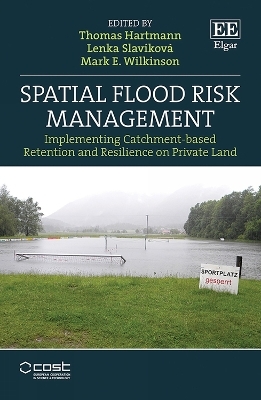
Spatial Flood Risk Management
Edward Elgar Publishing Ltd (Verlag)
978-1-80037-952-7 (ISBN)
Centralizing the role of land and landowners, Spatial Flood Risk Management brings together knowledge from socio-economy, public policy, hydrology, geomorphology, and engineering to establish an interdisciplinary knowledge base on spatial approaches to managing flood risks.
Discussing key barriers and sharing evidence-based best practices to flood risk management, international contributors involved in the LAND4FLOOD EU COST Action initiative (CA16209) seek transferrable solutions to the implementation challenges of nature-based solutions. Introducing the concept of spatial flood risk management, the multi-national teams of authors consider the notion of land through three analytical lenses: as a biophysical system, a socio-economic resource, and a solution to flood-risk management. Advocating for a more comprehensive approach, the book explores options of where and how to store water within catchments, including decentralized water retention in the hinterland, flood storage along rivers, and planned flooding in resilient cities.
Bringing together the existing knowledge on the relation between flood risk management and land with an international and interdisciplinary scope, this book will prove invaluable to academics, policy makers and public authorities involved in flood risk management, urban planners, and governing environmental bodies.
Edited by Thomas Hartmann, School of Spatial Planning, TU Dortmund University, Germany, Lenka Slavíková, Faculty of Social and Economic Studies and Institute for Economic and Environmental Policy (IEEP), Jan Evangelista Purkyně University, Czech Republic and Mark E. Wilkinson, Department of Environmental and Biochemical Sciences, James Hutton Institute, UK
Contents:
Foreword xii
Sally Priest
Acknowledgement xiv
1 Introduction to Spatial Flood Risk Management:
Implementing Catchment-based Retention and Resilience
on Private Land 1
Thomas Hartmann, Lenka Slavíková and Mark E. Wilkinson
PART I WATER RETENTION IN THE HINTERLAND
2 Nature-based solutions for flow reduction in catchment
headwaters 13
Mary Bourke, Mark E. Wilkinson and Zorica Srdjevic
3 Legal challenges of restricting land use for natural flood
protection in the hinterland 33
Juliane Albrecht and Sofija Nikolić Popadić
4 Implementation of measures in the hinterland: transaction
costs and economic instruments 52
Gábor Ungvári and Dennis Collentine
PART II FLOOD STORAGE ALONG RIVERS
5 Technical and hydrological effects across scales and
thresholds of polders, dams and levees 68
Reinhard Pohl and Nejc Bezak
6 Financial compensation and legal restrictions for using
land for flood retention 89
Andras Kis, Arthur Schindelegger and Vesna Zupanc
7 Upstream-downstream schemes and their instruments 106
Thomas Hartmann, Lukas Löschner and Jan Macháč
PART III RESILIENT CITIES
8 Individual measures for adaptive cities 120
Christin Rinnert, Thomas Thaler and Robert Jüpner
9 Institutionalizing the resilient city: constraints and opportunities 134
Rares Halbac-Cotoara-Zamfir and Barbara Tempels
10 The role of risk transfer and spatial planning for enhancing
the flood resilience of cities 148
Paul Hudson and Lenka Slavíková
PART IV CONCLUSION
11 Challenges of spatial flood risk management 164
Thomas Hartmann, Lenka Slavíková and Mark E.
Wilkinson
Index
| Erscheinungsdatum | 19.04.2022 |
|---|---|
| Verlagsort | Cheltenham |
| Sprache | englisch |
| Maße | 156 x 234 mm |
| Themenwelt | Sonstiges ► Geschenkbücher |
| Naturwissenschaften ► Biologie ► Ökologie / Naturschutz | |
| Naturwissenschaften ► Geowissenschaften ► Geografie / Kartografie | |
| Technik ► Bauwesen | |
| ISBN-10 | 1-80037-952-8 / 1800379528 |
| ISBN-13 | 978-1-80037-952-7 / 9781800379527 |
| Zustand | Neuware |
| Haben Sie eine Frage zum Produkt? |
aus dem Bereich


